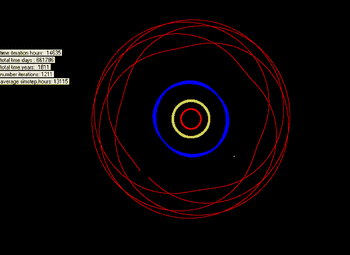Astronomy:(182294) 2001 KU76
From HandWiki
Short description: Trans-Neptunian object
| Discovery[1] | |
|---|---|
| Discovered by | Buie, M. W. |
| Discovery date | 24 May 2001 |
| Designations | |
| (182294) 2001 KU76 | |
| Minor planet category | Trans-Neptunian object 6:11 resonance?[2][3] |
| Orbital characteristics[1] | |
| Epoch 13 January 2016 (JD 2457400.5) | |
| Uncertainty parameter 4 | |
| Observation arc | 2536 days (6.94 yr) |
| |{{{apsis}}}|helion}} | 52.656 astronomical unit|AU (7.8772 Tm) (Q) |
| |{{{apsis}}}|helion}} | 37.693 AU (5.6388 Tm) (q) |
| 45.175 AU (6.7581 Tm) (a) | |
| Eccentricity | 0.16561 (e) |
| Orbital period | 303.63 yr (110903 d) |
| Mean anomaly | 354.46° (M) |
| Mean motion | 0° 0m 11.686s / day (n) |
| Inclination | 10.637° (i) |
| Longitude of ascending node | 44.987° (Ω) |
| |{{{apsis}}}|helion}} | ≈ 6 December 2021[4] ±3 months |
| 204.39° (ω) | |
| Earth MOID | 36.6816 AU (5.48749 Tm) |
| Jupiter MOID | 32.3615 AU (4.84121 Tm) |
| Physical characteristics | |
| Dimensions | 211 km (assumed)[5] |
| Geometric albedo | 0.09 (assumed) |
| Absolute magnitude (H) | 6.6[1] |
(182294) 2001 KU76, provisionally known as 2001 KU76, is a trans-Neptunian object (TNO) that has a possible 6:11 resonance with Neptune.[2][3]
It will come to perihelion around December 2021.[4]
Assuming a generic TNO albedo of 0.09, it is about 211 km in diameter.[5] The assumed diameter of this object makes it a possible dwarf planet.[6]
Resonance
Simulations by Lykawka in 2007 show that (182294) 2001 KU76 may be librating in the 11:6 resonance with Neptune.[2] Buie classifies it as probably in resonance, although some possible orbits do not librate.[3] (182294) 2001 KU76 has a semi-major axis of 45 AU and an orbital period of about 302 years.[1]
It has been observed 29 times over 6 years and has an orbit quality code of 4.[1]
References
- ↑ 1.0 1.1 1.2 1.3 1.4 "JPL Small-Body Database Browser: 182294 (2001 KU76)". https://ssd.jpl.nasa.gov/sbdb.cgi?sstr=182294. Retrieved 7 April 2016.
- ↑ 2.0 2.1 2.2 Lykawka, Patryk Sofia; Mukai, Tadashi (July 2007). "Dynamical classification of trans-neptunian objects: Probing their origin, evolution, and interrelation". Icarus 189 (1): 213–232. doi:10.1016/j.icarus.2007.01.001. Bibcode: 2007Icar..189..213L.
- ↑ 3.0 3.1 3.2 "Orbit Fit and Astrometric record for 182294". SwRI (Space Science Department). http://www.boulder.swri.edu/~buie/kbo/astrom/182294.html. Retrieved 2009-02-06.
- ↑ 4.0 4.1 JPL Horizons Observer Location: @sun (Perihelion occurs when deldot changes from negative to positive. Uncertainty in time of perihelion is 3-sigma.)
- ↑ 5.0 5.1 Johnston, Wm. Robert (22 August 2008). "List of Known Trans-Neptunian Objects". Johnston's Archive. http://www.johnstonsarchive.net/astro/tnoslist.html. Retrieved 2009-02-06.
- ↑ Brown, Michael E.. "How many dwarf planets are there in the outer solar system? (updates daily)". California Institute of Technology. Archived from the original on 2011-10-18. https://web.archive.org/web/20111018154917/http://www.gps.caltech.edu/~mbrown/dps.html. Retrieved 2012-09-04.
External links
 |


